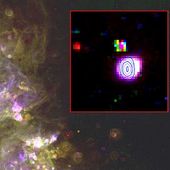
Objects roughly one-third to two-thirds the size of the sun blow out their mass into beautifully glowing shells of gas and dust called planetary nebulae.
But no similar structures have been found for stars about one to eight times the size of the sun.
Now a team of Australian and U.S. scientists think they have an answer: The bigger stars create planetary nebulae that radiate strongly in radio waves, as opposed to visible light. They call these new objects "super planetary nebulae."
"There's been a difference between what (these stars) should have shed and what has been assessed," astronomer Martin Cohen, with the University of California at Berkeley, told Discovery News.
The team used radio telescopes to survey the Magellanic Clouds, two galaxies neighboring our own Milky Way. They then compared the radio images with existing optical surveys.
"One obvious and very bright object in the Small Magellanic Cloud was also shining in our radio images. We cross-checked if it was cataloged as an optical object and then we found that at the same position exist previously classified optical planetary nebulae. My first reaction was 'No way! Come back tomorrow, re-check everything, and think again,'" lead astronomer Miroslav Filipovic, with the University of Western Sydney, said in an email to Discovery News.
The team rechecked their observations, found them correct, then looked to see if any other optical planetary nebulae could be seen in the radio images.
"The biggest shock," wrote Filipovic. "We found 15 of them shining like beacons."



Reader Comments
to our Newsletter